
William Hay (architect)
Encyclopedia
William Hay was a Scottish architect
who was actively working internationally from 1842 to 1887. A specialist in gothic architecture
, he is primarily known for his work on several churches and cathedrals. His most famous structure is the Bermuda Cathedral in Hamilton, Bermuda
which he designed in 1885. Construction of the cathedral began in 1886 and was completed seven years after Hay's death in 1905. He also designed some of the oldest buildings and structures in Toronto, Ontario
, (then called Canada West) from 1853-1861, and was responsible for the restoration of St. Giles' Cathedral
in Edinburgh from 1872-1884. His career exemplifies how the British Empire
of the Victorian Era
was united not only by military and political strength but also by professionals who took advantages of opportunities in its wide array of territories.
, Hay was named after his father who was a Scottish Episcopalian grain merchant. In his youth he was apprenticed to a joiner
, but an accident during a job at Ellishill House which broke his leg ended his career in this area. The treating doctor for his injury encouraged him to study architecture during his recovery and his career accordingly took a turn in that direction.
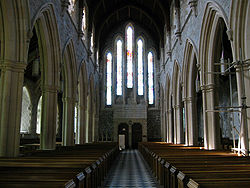 Hay tackled his first job as an architect at the age of 24 with the St James Episcopal Church in Cruden Bay
Hay tackled his first job as an architect at the age of 24 with the St James Episcopal Church in Cruden Bay
in 1842-1843. He married his first wife, Janet Reid (1819-1860), in 1844, and that same year relocated to Edinburgh to become an assistant to architect John Henderson
.
After working with Henderson for two years, Hay moved to London to apprentice with George Gilbert Scott
in 1846. Scott entrusted him with overseeing the building of the nave
of the Cathedral of St. John the Baptist
in St. John's, Newfoundland
. For that project he travelled throughout England and Scotland in late 1846 and early 1847 to acquire materials and skilled craftsmen. In April 1847 he, along with his wife and her brother Thomas (their ward), sailed to Newfoundland. He remained there until the nave was completed in 1850.
Hay spent some time in his native town working in 1850-1853, building there St. John's Episcopal Church, Longside and a house at No 22 Broad Street for his mother, Jean Hay (née Alexander). During this time he considered setting up practice in either Montreal
, Canada East
, or Chicago
, Illinois
, and made visits to those cities. He ultimately settled on establishing his practice in Toronto
, and accordingly moved there in late 1853. He remained in that city until late 1861, following the sudden death of his wife, who never bore children, in 1860.
While in Toronto, Hay developed a highly successful architecture firm which he left to his recently acquired partner, Thomas Gundry. His aprentice Henry Langley
became Gundry's new partner upon his departure. In Toronto he designed the Toronto General Hospital
(1855), St. Basil's Church, Toronto
(1855-1856), the House of Providence
(1855–1858), two of the original buildings at the University of St. Michael's College
(1856), the school addition to the Church of the Holy Trinity (1858), the Yorkville Town Hall
(1859-1860), and the Oaklands at De La Salle College (1860) among other structures. He also served on the council of the Royal Canadian Institute
(1858–1860), was the Vice-President of the Toronto Mechanics' Institute
(1859–1861), and was Secretary of the Association of Architects Civil Engineers and Provincial Surveyors of Canada.
in Hamilton. He had previously been consulted in 1848-1849 for work on the cathedral by Bishop Reid; having reviewed James Cranston of Oxford's 1844 designs for the structure. He had made several alterations to those plans at that time, but the building of the cathedral had not commenced until several years later. The cathedral was completed in 1869 but was destroyed by arson in 1884. Hay was approached at that time to design the current Bermuda Cathedral in the neo-Gothic style. Built between 1886-1905, it was his last significant work and his most famous.
In 1862 Hay formed a partnership with architect David Stirling
in Halifax, Novia Scotia. They worked together through 1865 on the Halifax Club (1862), Alexander Keith's residence (1863), and a new Provincial Building designed for use as a post office, customs house, and railway department (built from 1863-1868, now the Art Gallery of Nova Scotia
). He married his second wife, Jemima Huddleston (1838-1905) of Ryde, Isle of Wight, in 1864. The couple produced one daughter, Fanny, and settled in Edinburgh where Hay set up a new practice.
In 1871 he was hired by Sir William Chambers, Lord Provost of Edinburgh, to oversee the restoration of St. Giles' Cathedral
which took place from 1872-1884. In 1877 he formed a partnership with John Henderson's son George Henderson
. The two men worked together until Hay became seriously ill in October 1887. He died eight months later at Rabbit Hall, Hamilton Street, Joppa at the age of 70.
Architect
An architect is a person trained in the planning, design and oversight of the construction of buildings. To practice architecture means to offer or render services in connection with the design and construction of a building, or group of buildings and the space within the site surrounding the...
who was actively working internationally from 1842 to 1887. A specialist in gothic architecture
Gothic architecture
Gothic architecture is a style of architecture that flourished during the high and late medieval period. It evolved from Romanesque architecture and was succeeded by Renaissance architecture....
, he is primarily known for his work on several churches and cathedrals. His most famous structure is the Bermuda Cathedral in Hamilton, Bermuda
Hamilton, Bermuda
Hamilton is the capital of the British Overseas Territory of Bermuda. It is the territory's financial centre and a major port and tourist destination.-Geography:...
which he designed in 1885. Construction of the cathedral began in 1886 and was completed seven years after Hay's death in 1905. He also designed some of the oldest buildings and structures in Toronto, Ontario
Ontario
Ontario is a province of Canada, located in east-central Canada. It is Canada's most populous province and second largest in total area. It is home to the nation's most populous city, Toronto, and the nation's capital, Ottawa....
, (then called Canada West) from 1853-1861, and was responsible for the restoration of St. Giles' Cathedral
St. Giles' Cathedral
St Giles' Cathedral, more properly termed the High Kirk of Edinburgh, is the principal place of worship of the Church of Scotland in Edinburgh. Its distinctive crown steeple is a prominent feature of the city skyline, at about a third of the way down the Royal Mile which runs from the Castle to...
in Edinburgh from 1872-1884. His career exemplifies how the British Empire
British Empire
The British Empire comprised the dominions, colonies, protectorates, mandates and other territories ruled or administered by the United Kingdom. It originated with the overseas colonies and trading posts established by England in the late 16th and early 17th centuries. At its height, it was the...
of the Victorian Era
Victorian era
The Victorian era of British history was the period of Queen Victoria's reign from 20 June 1837 until her death on 22 January 1901. It was a long period of peace, prosperity, refined sensibilities and national self-confidence...
was united not only by military and political strength but also by professionals who took advantages of opportunities in its wide array of territories.
Early life: 1818-1841
Born at Dykeside, PeterheadPeterhead
Peterhead is a town in Aberdeenshire, Scotland. It is Aberdeenshire's biggest settlement , with a population of 17,947 at the 2001 Census and estimated to have fallen to 17,330 by 2006....
, Hay was named after his father who was a Scottish Episcopalian grain merchant. In his youth he was apprenticed to a joiner
Joiner
A joiner differs from a carpenter in that joiners cut and fit joints in wood that do not use nails. Joiners usually work in a workshop since the formation of various joints generally requires non-portable machinery. A carpenter normally works on site...
, but an accident during a job at Ellishill House which broke his leg ended his career in this area. The treating doctor for his injury encouraged him to study architecture during his recovery and his career accordingly took a turn in that direction.
Early career: 1842-1861

Cruden Bay
Cruden Bay is a small village in Scotland, on the north coast of the Bay of Cruden in Aberdeenshire, 26 miles north of Aberdeen.Just south of Slains Castle, Cruden Bay was the site of a battle between Danes and Scots under King Malcolm II in 1012...
in 1842-1843. He married his first wife, Janet Reid (1819-1860), in 1844, and that same year relocated to Edinburgh to become an assistant to architect John Henderson
John Henderson (architect)
John Henderson was a Scottish architect. He is chiefly remembered as an ecclesiastical and tractarian architect working in the Gothic style....
.
After working with Henderson for two years, Hay moved to London to apprentice with George Gilbert Scott
George Gilbert Scott
Sir George Gilbert Scott was an English architect of the Victorian Age, chiefly associated with the design, building and renovation of churches, cathedrals and workhouses...
in 1846. Scott entrusted him with overseeing the building of the nave
Nave
In Romanesque and Gothic Christian abbey, cathedral basilica and church architecture, the nave is the central approach to the high altar, the main body of the church. "Nave" was probably suggested by the keel shape of its vaulting...
of the Cathedral of St. John the Baptist
Cathedral of St. John the Baptist (St. John's)
The Cathedral of St. John the Baptist is located in the city of St. John's, Newfoundland. This parish in the Diocese of Eastern Newfoundland and Labrador was founded in 1699 in response to a petition drafted by the Anglican townsfolk of St. John's and sent to the Bishop of London, the Rt. Rev....
in St. John's, Newfoundland
St. John's, Newfoundland and Labrador
St. John's is the capital and largest city in Newfoundland and Labrador, and is the oldest English-founded city in North America. It is located on the eastern tip of the Avalon Peninsula on the island of Newfoundland. With a population of 192,326 as of July 1, 2010, the St...
. For that project he travelled throughout England and Scotland in late 1846 and early 1847 to acquire materials and skilled craftsmen. In April 1847 he, along with his wife and her brother Thomas (their ward), sailed to Newfoundland. He remained there until the nave was completed in 1850.
Hay spent some time in his native town working in 1850-1853, building there St. John's Episcopal Church, Longside and a house at No 22 Broad Street for his mother, Jean Hay (née Alexander). During this time he considered setting up practice in either Montreal
Montreal
Montreal is a city in Canada. It is the largest city in the province of Quebec, the second-largest city in Canada and the seventh largest in North America...
, Canada East
Canada East
Canada East was the eastern portion of the United Province of Canada. It consisted of the southern portion of the modern-day Canadian Province of Quebec, and was primarily a French-speaking region....
, or Chicago
Chicago
Chicago is the largest city in the US state of Illinois. With nearly 2.7 million residents, it is the most populous city in the Midwestern United States and the third most populous in the US, after New York City and Los Angeles...
, Illinois
Illinois
Illinois is the fifth-most populous state of the United States of America, and is often noted for being a microcosm of the entire country. With Chicago in the northeast, small industrial cities and great agricultural productivity in central and northern Illinois, and natural resources like coal,...
, and made visits to those cities. He ultimately settled on establishing his practice in Toronto
Toronto
Toronto is the provincial capital of Ontario and the largest city in Canada. It is located in Southern Ontario on the northwestern shore of Lake Ontario. A relatively modern city, Toronto's history dates back to the late-18th century, when its land was first purchased by the British monarchy from...
, and accordingly moved there in late 1853. He remained in that city until late 1861, following the sudden death of his wife, who never bore children, in 1860.
While in Toronto, Hay developed a highly successful architecture firm which he left to his recently acquired partner, Thomas Gundry. His aprentice Henry Langley
Henry Langley (architect)
Henry Langley was a Canadian architect based in Toronto. He was active from 1854 to 1907. Among the first architects born and trained in Canada, he was a founding members of the Royal Canadian Academy of Arts in 1880 and was instrumental in establishing the Ontario Association of Architects in 1889...
became Gundry's new partner upon his departure. In Toronto he designed the Toronto General Hospital
Toronto General Hospital
The Toronto General Hospital , is a part of the University Health Network, and a major teaching hospital in downtown Toronto, Ontario. It is located in the Discovery District, directly north of the Hospital for Sick Children, across Gerrard Street West, and east of Princess Margaret Hospital and...
(1855), St. Basil's Church, Toronto
St. Basil's Church, Toronto
St Basil’s Church is a Canadian Roman Catholic church located in Toronto, Ontario. In addition to being a parish church, it is the collegiate church of the University of St. Michael's College which is a Federated college of the University of Toronto...
(1855-1856), the House of Providence
House of Providence
The House of Providence is a Roman Catholic charitable institution in the city of Toronto, Canada that has been active since 1857. Commissioned by Armand-François-Marie de Charbonnel, the second Roman Catholic Bishop of Toronto, the institution provides help to "the needy, the immigrants, the old,...
(1855–1858), two of the original buildings at the University of St. Michael's College
University of St. Michael's College
The University of St. Michael's College is a college of the University of Toronto, founded in 1852 by the Congregation of St. Basil of Annonay, France. While mainly an undergraduate college for liberal arts and sciences, St. Michael's retains its Roman Catholic affiliation through its postgraduate...
(1856), the school addition to the Church of the Holy Trinity (1858), the Yorkville Town Hall
Yorkville Town Hall
Yorkville Town Hall was the municipal building for the Town of Yorkville before annexation into the City of Toronto. Built in 1859-1860 by architect William Hay and his apprentice Henry Langley, the 3 storey building served as an omnibus stop. Located north of Bloor on Yonge Street, it was...
(1859-1860), and the Oaklands at De La Salle College (1860) among other structures. He also served on the council of the Royal Canadian Institute
Royal Canadian Institute
The Royal Canadian Institute, or RCI, is an organization dedicated to the advancement of science.First formed in 1849 by Sir Sandford Fleming, it was originally conceived of as an organization for engineers and surveyors, but quickly became more general in its scientific interests. Incorporated in...
(1858–1860), was the Vice-President of the Toronto Mechanics' Institute
Toronto Mechanics' Institute
The Toronto Mechanics' Institute, originally named the York Mechanics' Institute, was an educational institution in 19th century Toronto that became the city's first public library. It was one of a series of mechanics' institutes that were set up around the world after becoming popular in Britain...
(1859–1861), and was Secretary of the Association of Architects Civil Engineers and Provincial Surveyors of Canada.
Later career: 1862-1888
After some time spent in Scotland in 1861, Hay spent the year 1862 in Bermuda consulting on problems developed during the building of the first Cathedral of the Most Holy TrinityCathedral of the Most Holy Trinity
The Cathedral of the Most Holy Trinity is an Anglican cathedral located on Church Street in Hamilton, Bermuda. The original building was designed in the Old English style by James Cranston of Oxford in 1844 and was completed in 1869. That building was destroyed by fire in 1884...
in Hamilton. He had previously been consulted in 1848-1849 for work on the cathedral by Bishop Reid; having reviewed James Cranston of Oxford's 1844 designs for the structure. He had made several alterations to those plans at that time, but the building of the cathedral had not commenced until several years later. The cathedral was completed in 1869 but was destroyed by arson in 1884. Hay was approached at that time to design the current Bermuda Cathedral in the neo-Gothic style. Built between 1886-1905, it was his last significant work and his most famous.
In 1862 Hay formed a partnership with architect David Stirling
David Stirling (architect)
David Stirling was a Canadian architect of Scottish birth. In 1872 he was made Dominion architect for the federal works in Nova Scotia and in 1880 he became one of the first associate architects of the Royal Canadian Academy of Arts.Born in Galashiels, Stirling was the son of stonemason James...
in Halifax, Novia Scotia. They worked together through 1865 on the Halifax Club (1862), Alexander Keith's residence (1863), and a new Provincial Building designed for use as a post office, customs house, and railway department (built from 1863-1868, now the Art Gallery of Nova Scotia
Art Gallery of Nova Scotia
The Art Gallery of Nova Scotia is the provincial art gallery for the province of Nova Scotia. It is located in the central downtown region of Halifax, Nova Scotia, Canada with a branch gallery in Yarmouth, Nova Scotia....
). He married his second wife, Jemima Huddleston (1838-1905) of Ryde, Isle of Wight, in 1864. The couple produced one daughter, Fanny, and settled in Edinburgh where Hay set up a new practice.
In 1871 he was hired by Sir William Chambers, Lord Provost of Edinburgh, to oversee the restoration of St. Giles' Cathedral
St. Giles' Cathedral
St Giles' Cathedral, more properly termed the High Kirk of Edinburgh, is the principal place of worship of the Church of Scotland in Edinburgh. Its distinctive crown steeple is a prominent feature of the city skyline, at about a third of the way down the Royal Mile which runs from the Castle to...
which took place from 1872-1884. In 1877 he formed a partnership with John Henderson's son George Henderson
George Henderson (architect)
-Life and career:Born in Edinburgh, Henderson was the son of architect John Henderson and Hannah Matilda Exley. From 1858–1861 he attended the Royal High School, Edinburgh. He then studied architecture under his father, but his studies were cut short when his father died in June 1862...
. The two men worked together until Hay became seriously ill in October 1887. He died eight months later at Rabbit Hall, Hamilton Street, Joppa at the age of 70.
Selected works
| Building | Year Completed | Builder | Style | Source | Location | Image |
|---|---|---|---|---|---|---|
| St. Michael's College University of St. Michael's College The University of St. Michael's College is a college of the University of Toronto, founded in 1852 by the Congregation of St. Basil of Annonay, France. While mainly an undergraduate college for liberal arts and sciences, St. Michael's retains its Roman Catholic affiliation through its postgraduate... |
1856 | William Hay (architect) William Hay (architect) William Hay was a Scottish architect who was actively working internationally from 1842 to 1887. A specialist in gothic architecture, he is primarily known for his work on several churches and cathedrals. His most famous structure is the Bermuda Cathedral in Hamilton, Bermuda which he designed in... |
Gothic architecture Gothic architecture Gothic architecture is a style of architecture that flourished during the high and late medieval period. It evolved from Romanesque architecture and was succeeded by Renaissance architecture.... |
2 | 50 Saint Joseph Street Toronto, Ontario | 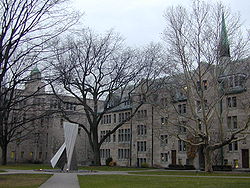 |
| St. Basil's Church, Toronto St. Basil's Church, Toronto St Basil’s Church is a Canadian Roman Catholic church located in Toronto, Ontario. In addition to being a parish church, it is the collegiate church of the University of St. Michael's College which is a Federated college of the University of Toronto... |
1855–1856 | William Hay (architect) William Hay (architect) William Hay was a Scottish architect who was actively working internationally from 1842 to 1887. A specialist in gothic architecture, he is primarily known for his work on several churches and cathedrals. His most famous structure is the Bermuda Cathedral in Hamilton, Bermuda which he designed in... |
Gothic architecture Gothic architecture Gothic architecture is a style of architecture that flourished during the high and late medieval period. It evolved from Romanesque architecture and was succeeded by Renaissance architecture.... |
St. Joseph Street west of Bay Street, Toronto, Ontario | 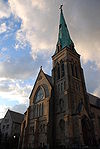 |
|
| Oaklands | 1860 | John Macdonald John Macdonald (Canadian politician) John Macdonald was a Canadian merchant, churchman, philanthropist, and politician in the late 19th century in Toronto. He was a major patron of the Young Men's Christian Association and the Toronto General Hospital... , design William Hay William Hay (architect) William Hay was a Scottish architect who was actively working internationally from 1842 to 1887. A specialist in gothic architecture, he is primarily known for his work on several churches and cathedrals. His most famous structure is the Bermuda Cathedral in Hamilton, Bermuda which he designed in... |
Gothic architecture Gothic architecture Gothic architecture is a style of architecture that flourished during the high and late medieval period. It evolved from Romanesque architecture and was succeeded by Renaissance architecture.... |
8 | De La Salle College De La Salle College (Toronto) De La Salle College "Oaklands" is an independent co-educational Catholic school in Toronto, Ontario. It is operated by the Institute of the Brothers of the Christian Schools as a university preparatory institution in the Roman Catholic tradition as founded by Saint Jean-Baptiste de la Salle in... , Toronto, Ontario |
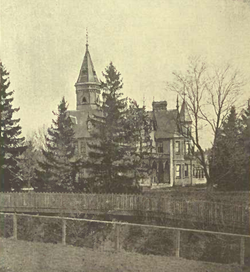 |
| Holy Trinity Rectory | 1861 | William Hay (architect) William Hay (architect) William Hay was a Scottish architect who was actively working internationally from 1842 to 1887. A specialist in gothic architecture, he is primarily known for his work on several churches and cathedrals. His most famous structure is the Bermuda Cathedral in Hamilton, Bermuda which he designed in... |
Gothic architecture Gothic architecture Gothic architecture is a style of architecture that flourished during the high and late medieval period. It evolved from Romanesque architecture and was succeeded by Renaissance architecture.... |
15 | 10 Trinity Square Trinity Square (Toronto) Trinity Square is a public square in downtown Toronto, Ontario, Canada. It is bounded by the Toronto Eaton Centre, an office building known as Bell Trinity Square, and the Marriott Downtown Eaton Centre Hotel. The square's primary feature is the Anglican Church of the Holy Trinity... , Toronto, Ontario |
|
| Art Gallery of Nova Scotia Art Gallery of Nova Scotia The Art Gallery of Nova Scotia is the provincial art gallery for the province of Nova Scotia. It is located in the central downtown region of Halifax, Nova Scotia, Canada with a branch gallery in Yarmouth, Nova Scotia.... |
1863-1868 | William Hay (architect) William Hay (architect) William Hay was a Scottish architect who was actively working internationally from 1842 to 1887. A specialist in gothic architecture, he is primarily known for his work on several churches and cathedrals. His most famous structure is the Bermuda Cathedral in Hamilton, Bermuda which he designed in... |
Gothic architecture Gothic architecture Gothic architecture is a style of architecture that flourished during the high and late medieval period. It evolved from Romanesque architecture and was succeeded by Renaissance architecture.... |
Halifax, Nova Scotia | ||
| St. Giles' Cathedral St. Giles' Cathedral St Giles' Cathedral, more properly termed the High Kirk of Edinburgh, is the principal place of worship of the Church of Scotland in Edinburgh. Its distinctive crown steeple is a prominent feature of the city skyline, at about a third of the way down the Royal Mile which runs from the Castle to... |
1872-1884 | William Hay (architect) William Hay (architect) William Hay was a Scottish architect who was actively working internationally from 1842 to 1887. A specialist in gothic architecture, he is primarily known for his work on several churches and cathedrals. His most famous structure is the Bermuda Cathedral in Hamilton, Bermuda which he designed in... and George Henderson (architect) George Henderson (architect) -Life and career:Born in Edinburgh, Henderson was the son of architect John Henderson and Hannah Matilda Exley. From 1858–1861 he attended the Royal High School, Edinburgh. He then studied architecture under his father, but his studies were cut short when his father died in June 1862... |
Gothic architecture Gothic architecture Gothic architecture is a style of architecture that flourished during the high and late medieval period. It evolved from Romanesque architecture and was succeeded by Renaissance architecture.... |
Edinburgh, Scotland | 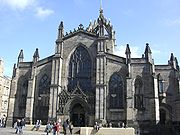 |
|
| Bermuda Cathedral | 1885 | William Hay (architect) William Hay (architect) William Hay was a Scottish architect who was actively working internationally from 1842 to 1887. A specialist in gothic architecture, he is primarily known for his work on several churches and cathedrals. His most famous structure is the Bermuda Cathedral in Hamilton, Bermuda which he designed in... and George Henderson (architect) George Henderson (architect) -Life and career:Born in Edinburgh, Henderson was the son of architect John Henderson and Hannah Matilda Exley. From 1858–1861 he attended the Royal High School, Edinburgh. He then studied architecture under his father, but his studies were cut short when his father died in June 1862... |
Gothic architecture Gothic architecture Gothic architecture is a style of architecture that flourished during the high and late medieval period. It evolved from Romanesque architecture and was succeeded by Renaissance architecture.... |
Hamilton, Bermuda Hamilton, Bermuda Hamilton is the capital of the British Overseas Territory of Bermuda. It is the territory's financial centre and a major port and tourist destination.-Geography:... |
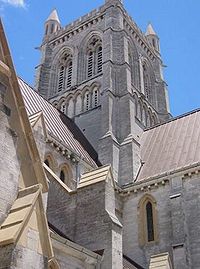 |
|

